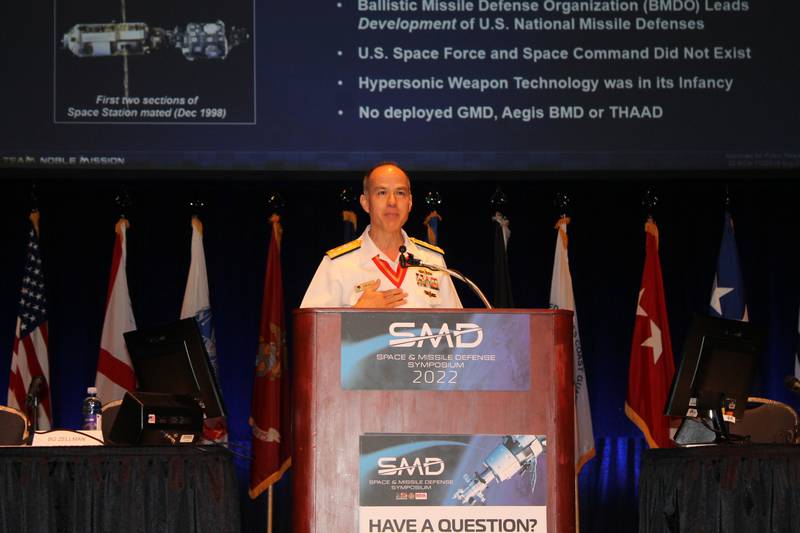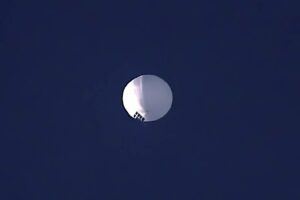HUNTSVILLE, Ala. — Using advanced digital design methods, the two teams competing to develop the Missile Defense Agency’s Next-Generation Interceptor are nearing a key milestone by the end of the year: a preliminary design review for the all-up round.
The agency chose two teams – Northrop Grumman working with Raytheon Technologies, an RTX company, and Lockheed Martin with Aerojet Rocketdyne – to design a replacement for the Ground-based Midcourse Defense system’s Ground-Based Interceptors. The contracts for both teams are worth $1.6 billion in total.
“We have finished the [solid rocket motor] case manufacturing for all three stages of NGI,” Lisa Brown, who runs Northrop Grumman’s bid, told a group of reporters Aug. 7 at the company’s brand-new facilities here, built partly for the NGI effort. “We’re going to be filling these cases with inert propellant. We’ll be shipping them here to Redstone Arsenal, where we will start doing integration work” into an interceptor, she said.
And the company is planning to start static firings of its solid rocket motors for the NGI program by the end of 2023, Brown added.
Lockheed Martin announced also on Aug. 7 in a statement that it had “successfully validated designs for all elements” of its NGI design with the Missile Defense Agency.
“Through a series of successful and on-schedule Preliminary Design Reviews (PDRs) of all NGI major subsystems, the company demonstrated it has achieved design maturity and reduced risk for critical technologies,” the statement reads.
Over a year ago, both teams competing set out to plant deeper roots in Huntsville as part of an effort to try to speed up NGI’s fielding as intercontinental ballistic missile threats from North Korea and Iran grow.
Lockheed Martin broke ground on a new $16.5 million, 25,000-square-foot Missile System Integration Lab in Huntsville in 2022 exclusively for the development of NGI, and Northrop began building two large facilities around the same time. Northrop’s two buildings are now open for business.
There are 44 GBIs in the ground with the majority in silos at Fort Greely, Alaska, and the rest at Vandenberg Space Force Base, California. The current interceptors aren’t equipped to counter a missile that could contain multiple kill vehicles or decoys that make the defeat process more complicated, defense officials have said.
Vice Adm. Jon Hill, who was the MDA’s director until last month, said the goal was to get NGI loaded into underground silos beginning around 2028. But both teams have said they can get there one year earlier.
RELATED

The companies are designing the new interceptor using digital methods meant to speed up the design process. As a result, Northrop’s engineers were able to build hardware earlier and begin testing sooner, Brown said.
Likewise, Lockheed also has touted its engineering orthodoxy. “We took a modern and transparent approach through the use of advanced digital engineering and model-based engineering tools,” Sarah Reeves, the company’s vice president in charge of the NGI bid, said in the statement. The company is working within an “integrated digital tool chain” to make decisions quickly and to stay flexible, it reads.
Brown said her team expected to complete the All Up Round Preliminary Design Review by the end of 2023 and Lockheed reported that it was “on track” for the same milestone.
Once both teams pass the review, they anticipate another, more detailed evaluation to follow roughly one year later in 2024.
RELATED

NGI is the result of the Pentagon canceling in August 2019 its Redesigned Kill Vehicle program – which would have upgraded the GBI to be able to pursue more complex threats. That program struggled with insurmountable technical issues resulting in delayed schedules and cost increases. Raytheon, as a subcontractor for Boeing, was the developer for the RKV program.
Roughly eight months after the cancellation of the RKV program, MDA launched the new interceptor push.
An independent cost estimate from the Defense Department’s Cost Assessment and Program Evaluation office determined in 2021 the total price tag to develop NGI could come to roughly $13 billion, while procurement, operation and sustainment could add to a little more than $2 billion.
Jen Judson is an award-winning journalist covering land warfare for Defense News. She has also worked for Politico and Inside Defense. She holds a Master of Science degree in journalism from Boston University and a Bachelor of Arts degree from Kenyon College.
- SEO Powered Content & PR Distribution. Get Amplified Today.
- PlatoData.Network Vertical Generative Ai. Empower Yourself. Access Here.
- PlatoAiStream. Web3 Intelligence. Knowledge Amplified. Access Here.
- PlatoESG. Automotive / EVs, Carbon, CleanTech, Energy, Environment, Solar, Waste Management. Access Here.
- BlockOffsets. Modernizing Environmental Offset Ownership. Access Here.
- Source: https://www.defensenews.com/digital-show-dailies/smd/2023/08/08/industry-teams-near-milestone-to-build-novel-us-missile-interceptor/
- :has
- :is
- :where
- $UP
- 1
- 2021
- 2022
- 2023
- 2024
- 2028
- 25
- 7
- 70
- 8
- a
- Able
- achieved
- add
- added
- advanced
- After
- agency
- ago
- alaska
- All
- also
- an
- and
- announced
- Another
- anticipate
- approach
- ARE
- around
- Arsenal
- Arts
- AS
- assessment
- At
- Aug
- AUGUST
- award-winning
- base
- BE
- began
- begin
- Beginning
- bid
- Billion
- Boeing
- boston
- Boston University
- both
- Broke
- build
- Building
- built
- business
- but
- by
- california
- CAN
- Can Get
- case
- cases
- charge
- College
- come
- Companies
- company
- Company’s
- competing
- complete
- complex
- complicated
- contracts
- Cost
- could
- Counter
- covering
- critical
- Current
- decisions
- deeper
- Defense
- Degree
- Delayed
- demonstrated
- Design
- design process
- designing
- designs
- detailed
- determined
- develop
- Developer
- Development
- digital
- Director
- doing
- Earlier
- effort
- end
- Engineering
- Engineers
- equipped
- evaluation
- exclusively
- expected
- facilities
- false
- filling
- First
- flexible
- follow
- For
- Force
- Fort
- from
- GBI
- get
- goal
- going
- Ground
- Group
- Grow
- had
- Hardware
- Have
- her
- here
- holds
- http
- HTTPS
- image
- images
- in
- Increases
- industry
- inside
- integration
- InterContinental
- into
- Iran
- IT
- ITS
- jon
- journalism
- journalist
- jpg
- Key
- key milestone
- Kill
- korea
- lab
- Land
- large
- Last
- later
- launched
- little
- major
- Majority
- make
- manufactured
- manufacturing
- Martin
- master
- maturity
- meant
- methods
- milestone
- million
- Modern
- Month
- months
- more
- Motor
- Motors
- multiple
- Near
- nearing
- New
- news
- next-generation
- North
- North Korea
- novel
- now
- of
- Office
- officials
- on
- ONE
- open
- operation
- or
- out
- part
- pass
- pentagon
- photo
- planning
- plato
- Plato Data Intelligence
- PlatoData
- president
- price
- process
- procurement
- Program
- pursue
- Push
- quickly
- redesigned
- Reduced
- replacement
- Reported
- REST
- result
- resulting
- review
- Reviews
- Risk
- rocket
- roots
- roughly
- round
- rtx
- runs
- s
- Said
- same
- Science
- Screen
- Series
- set
- she
- Shipping
- silos
- solid
- Space
- Space Force
- speed
- stages
- start
- Statement
- stay
- successful
- Successfully
- system
- TAG
- team
- teams
- Technical
- Technologies
- Testing
- than
- that
- The
- Them
- There.
- These
- they
- threats
- three
- Through
- time
- to
- took
- tool
- tools
- Total
- touted
- transparent
- try
- two
- university
- until
- upgraded
- us
- use
- using
- validated
- vehicle
- Vehicles
- vice
- Vice President
- was
- we
- were
- which
- while
- WHO
- will
- with
- within
- worked
- working
- worth
- would
- year
- zephyrnet












